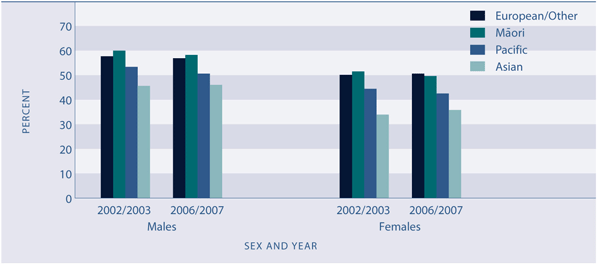Participation in physical activity
Definition
The proportion of the population aged 15 years and over who met physical activity guidelines (ie were physically active for at least 30 minutes a day on five or more days over the last week), as measured by the 2002/2003 and 2006/2007 New Zealand Health Surveys.
Relevance
Participation in physical activity is a source of enjoyment and has positive benefits for people’s physical and mental health. It can also contribute to personal growth and development and is a good way to meet new people.
Current level and trends
In 2006/2007, 51 percent of New Zealanders aged 15 years and over met physical activity guidelines, reporting they had been physically active for at least 30 minutes a day on five or more days over the last week. In 2002/2003, the proportion was 53 percent. However, the change between 2002/2003 and 2006/2007 was not statistically significant. The rates used in this section have been adjusted for age.
Sex and age differences
Males were significantly more likely than females to meet physical activity guidelines. In 2006/2007, 54 percent of males reported being physically active for at least 30 minutes a day on five or more days in the last week, compared to 47 percent of females.
Activity levels tend to decline with age. In 2006/2007, the proportion of the population who met physical activity guidelines was highest for age groups under 35 years and lowest for age groups over 65 years. Only for those aged 75 years and over were the proportions significantly lower than the rate for all ages.
Between 2002/2003 and 2006/2007, men in the 35–44 years and 45–54 years age groups recorded a decline in the proportion who met physical activity guidelines, as did women aged 55–64 years.
Table L2.1 Proportion (%) of the population aged 15 years and over who met physical activity guidelines in the last week, by age and sex, 2002/2003 and 2006/2007
| |
Males |
Females |
Total |
| Age group |
2002/2003 |
2006/2007 |
2002/2003 |
2006/2007 |
2002/2003 |
2006/2007 |
| 15-24 |
63.6 |
63.4 |
47.0 |
47.0 |
55.3 |
55.2 |
| 25-34 |
53.2 |
57.5 |
51.0 |
48.7 |
52.0 |
52.9 |
| 35-44 |
57.9 |
52.5 |
47.7 |
49.6 |
52.6 |
51.0 |
| 45-54 |
59.9 |
51.6 |
50.4 |
51.9 |
55.1 |
51.8 |
| 55-64 |
54.8 |
50.2 |
57.7 |
50.3 |
56.2 |
50.2 |
| 65-74 |
51.5 |
51.3 |
46.3 |
43.5 |
48.7 |
47.2 |
| 75+ |
36.1 |
40.6 |
29.8 |
26.3 |
32.6 |
32.4 |
| Total |
56.2 |
54.0 |
48.4 |
47.3 |
52.1 |
50.5 |
Source: Ministry of Health, Public Health Intelligence
Ethnic differences
Asians aged 15 years and over were significantly less likely than the population in that age group in general to have met physical activity guidelines in the previous week. In 2006/2007, the age-standardised rate for Asians was 40 percent while the rate for all New Zealanders aged 15 years and over was 51 percent. In each ethnic group other than Pacific peoples, males were significantly more likely than females to have met physical activity guidelines. These patterns were similar in 2002/2003.
Table L2.2 Proportion (%) of the population aged 15 years and over who met physical activity guidelines in the last week, by ethnic group and sex, 2002/2003 and 2006/2007
| |
Males |
Females |
Total |
| Ethnic group |
2002/2003 |
2006/2007 |
2002/2003 |
2006/2007 |
2002/2003 |
2006/2007 |
| European/Other |
57.4 |
56.6 |
49.9 |
50.3 |
53.5 |
53.3 |
| Māori |
59.7 |
57.9 |
51.2 |
49.4 |
55.2 |
53.4 |
| Pacific peoples |
53.2 |
50.4 |
44.2 |
42.3 |
48.5 |
46.1 |
| Asian |
45.3 |
45.8 |
33.8 |
35.6 |
39.1 |
40.4 |
| Total |
56.7 |
54.9 |
48.6 |
47.9 |
52.5 |
51.3 |
Source: Ministry of Health, Public Health Intelligence
Notes: (1) People who reported more than one ethnic group are counted once in each group reported (2) Age-standardised using WHO world population
Between 2002/2003 and 2006/2007, there were no significant increases in the rate at which the population aged 15 years and over met physical activity guidelines for any ethnic group.
Figure L2.1 Proportion of the population aged 15 years and over who met physical activity guidelines in the last week, by ethnic group and sex, 2002/2003 and 2006/2007

Source: Ministry of Health, Public Health Intelligence
Notes: (1) People who reported more than one ethnic group are counted once in each group reported (2) Age-standardised using WHO world population
Socio-economic differences
In 2006/2007, there was no association between physical activity and the level of neighbourhood deprivation (as measured by NZDep2006 quintiles). |

